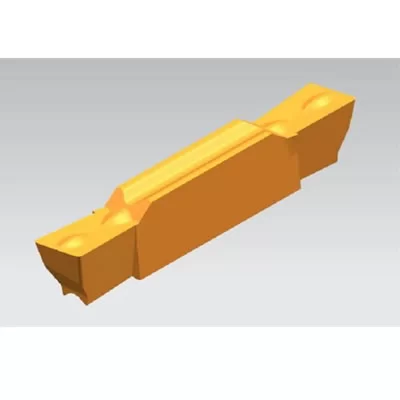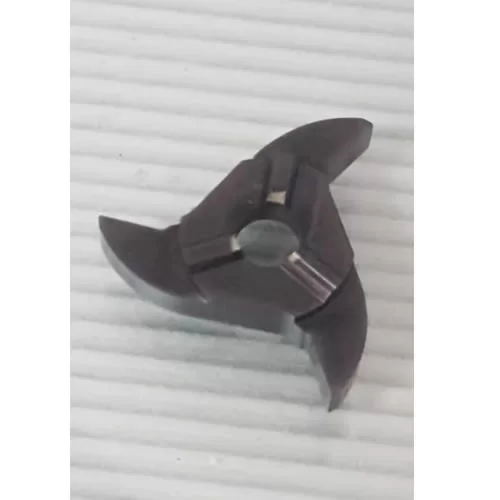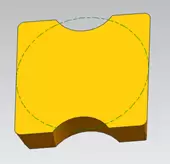Slotting Of Hardened Steel With PCBN Cutter
Slotting of hardened steel with PCBN cutter
In the past decade, precision grooving of hardened steel parts with polycrystalline cubic boron nitride (PCBN) inserts has gradually replaced traditional grinding. Tyler Economan, bidding engineering manager at Index, USA, said, “In general, grinding grooves are a more stable process that provides higher dimensional accuracy than grooving. However, people still want to be able to complete the workpiece on a lathe. A variety of processing required."
Various workpiece materials that have been hardened include high speed steel, die steel, bearing steel and alloy steel. Only ferrous metals can be hardened, and hardening processes are usually applied to low carbon steels. Through the hardening treatment, the external hardness of the workpiece can be made higher and wearable, while the interior has better toughness. Parts made of hardened steel include mandrels, axles, connectors, drive wheels, camshafts, gears, bushings, drive shafts, bearings, and the like.
However, "hard materials" is a relative, changing concept. Some people think that workpiece materials with a hardness of 40-55 HRC are hard materials; others believe that the hardness of hard materials should be 58-60 HRC or higher. In this category, PCBN tools can be used.
After induction hardening, the surface hardened layer can be up to 1.5mm thick and the hardness can reach 58-60 HRC, while the material below the surface layer is usually much softer. In this case, it is important to ensure that most of the cutting is done below the surface hardened layer.
Machine tools with sufficient power and rigidity are a necessary condition for grooving of hardened parts. According to Economan, “The better the rigidity of the machine tool and the higher the power, the more efficient the grooving of the hardened material. For workpiece materials with a hardness of more than 50 HRC, many light machine tools do not meet the required cutting conditions. If the machine capacity (power, torque, and especially rigidity) is exceeded, the machining cannot be completed successfully."
Rigidity is very important for the workpiece holding device because the contact surface of the cutting edge with the workpiece is large during the grooving process, and the tool exerts a great pressure on the workpiece. When clamping hardened steel workpieces, a wide clamp can be used to disperse the clamping surface. Paul Ratzki, marketing manager of Sumitomo Electric Hard Alloy Co., said, “The parts to be machined must be firmly supported. When machining hardened materials, the vibration and tool pressure generated are much larger than when machining ordinary workpieces, which may result in workpiece clamping. Can't fly out of the machine, or cause the CBN blade to chip or even break."
The shank that holds the grooving insert should be as short as possible to minimize overhang and increase tool rigidity. Matthew Schmitz, manager of GRIP products at Isca, points out that in general, monolithic tools are more suitable for grooving of hardened materials. However, the company also offers a modular grooving system. “The modular shank can be used in machining situations where the tool is prone to sudden failure,” he says. “You don’t have to replace the entire shank, you just need to replace a less expensive component. The modular shank also offers a variety of machining options. Iskar's Grip modular system can be installed in a variety of different products. You can use a tool holder with 7 different blades for 7 product lines or any number of blades for different processing The same product line with slot width."
Sumitomo Electric's toolholders for gripping CGA-type inserts use a top-clamping method that pulls the blade back into the holder. This holder also features a side fastening screw to help improve grip stability and extend tool life. Rich Maton, assistant manager of the company's design department, said, "This tool holder is designed for grooving of hardened workpieces. If the blade moves in the holder, the blade wears over time and the tool life changes. For the high-productivity machining requirements of the automotive industry (such as 50-100 or 150 workpieces per cutting edge), the predictability of tool life is particularly important, and changes in tool life can have a significant impact on production."
According to reports, Mitsubishi Materials' GY series Tri-Lock modular grooving system is comparable in rigidity to integral blade chucks. The system reliably grips the grooving blades from three directions (peripheral, front and top). Its two structural design prevents the blade from being displaced during grooving: the V-shaped projection prevents the blade from moving to the sides; the safety key eliminates the forward movement of the blade caused by the cutting force during slot machining.
Commonly used grooving inserts for hardened steel parts include simple square inserts, forming inserts, slotted inserts, and the like. Generally, the cut grooves are required to have a good surface finish because they have a mating portion, and some are O-rings or snap ring grooves. According to Mark Menconi, product specialist at Mitsubishi Materials, "These processes can be divided into inner diameter groove machining and outer diameter groove machining, but most grooving operations require fine cutting, including light touch precision from about 0.25 mm depth of cut. Cut to a full cut with a depth of about 0.5mm."
The grooving of hardened steel requires the use of tools with higher hardness, better wear resistance and suitable geometry. The key is to figure out whether a carbide insert, a ceramic insert or a PCBN insert should be used. Schmitz said, “I almost always choose carbide inserts when machining workpieces with hardnesses below 50 HRC. For workpieces with a hardness of 50-58 HRC, ceramic inserts are a very economical choice. Only when the workpiece CBN inserts should be considered for hardness up to 58 HRC. The CBN inserts are particularly suitable for machining such high-hard materials because the machining mechanism is not a cutting material but a tool/workpiece interface. Melt the material.
For grooving of hardened steel parts with a hardness of over 58 HRC, chip control is not a problem. Since dry grooving is usually used, the chips are more like dust or very small particles and can be removed by hand blow. Sumitomo Electric's Maton said, "Usually, this kind of swarf will break and disintegrate when it hits anything, so the contact of the swarf with the workpiece will not damage the workpiece. If you grab a swarf, they will smash in your hand. ”
One of the reasons why CBN inserts are suitable for dry cutting is that although their heat resistance is very good, the processing performance is greatly reduced in the case of temperature fluctuations. Economan says, “In fact, when the CBN insert is in contact with the workpiece material, it produces heat of cutting on the tip, but because the CBN insert is less adaptable to temperature changes, it is difficult to adequately cool to maintain a constant temperature. State. CBN is very hard, but it is also very brittle and may rupture due to temperature changes."
When cutting steel parts with low hardness (such as 45-50 HRC) with cemented carbide, ceramic or PCBN inserts, the generated chips should be as short as possible. This effectively removes the heat of cutting in the tool material during the cutting process because the chips can carry away a large amount of heat.
Iskar's Schmitz also recommends that the tool be processed in an "inverted" state. He explained, “When installing a tool on a machine tool, the machine tool builder's preferred tool is installed by cutting the blade face up, as this allows the rotation of the workpiece to exert downward pressure on the machine rail to keep the machine stable. However, when the blade is cut into the workpiece material, the formed chips may remain on the blade and the workpiece. If the tool holder is turned over and the tool is mounted upside down, the blade will not be visible, and the chip flow will automatically escape from the cutting area under the action of gravity."
Surface hardening is a simple method to improve the hardness of low carbon steel. The principle is to increase the carbon content at a certain depth under the surface of the material. When the grooving depth exceeds the thickness of the surface hardened layer, some problems may arise due to the change of the grooving blade from a harder material to a softer material. To this end, tool manufacturers have developed several blade grades for different types of workpiece materials.
Duane Drape, sales manager at Horn (USA), said, "When changing from a harder material to a softer material, the user doesn't always want to change the blade, so we have to find the best tool for this type of machining. If a cemented carbide insert is used, it will encounter the problem of excessive wear when the blade cuts a hard surface. If a CBN insert suitable for cutting high-hard materials is used to cut a soft part, it is easy to damage the blade. We can use a compromise: high hardness carbide inserts + super lubricated coatings, or relatively soft CBN insert grades + cutting inserts suitable for cutting common materials (rather than hard machining)."
Drape said, “You can use CBN inserts to effectively cut workpiece materials with a hardness of 45-50 HRC, but the blade geometry must be adjusted. Typical CBN inserts have a negative chamfer on the cutting edge. This negative chamfer CBN insert is softer to machine. When the workpiece material is used, the material will have a pull-out effect and the tool life will be shortened. If the CBN grade with lower hardness is used and the geometry of the cutting edge is changed, the workpiece material with a hardness of 45-50 HRC can be successfully cut."
The S117 HORN grooving insert developed by the company uses a PCBN tip, and the depth of cut is about 0.15-0.2 mm when the gear width is precisely cut. In order to achieve a good surface finish, the blade has a scraping plane on each of the cutting edges on both sides.
Another option is to change the cutting parameters. According to Index's Economan, “After cutting through the hardened layer, larger cutting parameters can be used. If the hardened depth is only 0.13mm or 0.25mm, after cutting through this depth, either the different blades are replaced or still Use the same blade, but increase the cutting parameters to the appropriate level."
In order to cover a wider range of processing, PCBN blade grades are increasing. Higher hardness grades allow for faster cutting speeds, while grades with better toughness can be used in more unstable processing environments. For continuous or interrupted cutting, different PCBN insert grades can also be used. Sumitomo Electric's Maton pointed out that due to the brittleness of PCBN tools, sharp cutting edges are prone to chipping when machining hardened steel. “We must protect the cutting edge, especially in interrupted cutting, the cutting edge should be prepared more than in continuous cutting, and the cutting angle should be larger.”
Iskar's newly developed IB10H and IB20H grades further expand its Groove Turn PCBN product line. IB10H is a fine-grained PCBN grade for medium to high speed continuous cutting of hardened steel; while IB20H consists of fine and medium grain size PCBN grains, providing good wear resistance and impact resistance. The balance can withstand the harsher conditions of hardened steel interrupted cutting. The normal failure mode of a PCBN tool should be that the cutting edge wears out rather than suddenly cracking or cracking.
The BNC30G coated PCBN grade introduced by Sumitomo Electric is used for interrupted grooving of hardened steel workpieces. For continuous grooving, the company recommends its BN250 universal blade grade. Maton said, “When cutting continuously, the blade is cut for a long time, which will generate a lot of cutting heat. Therefore, it is necessary to use a blade with good wear resistance. In the case of intermittent grooving, the blade continuously enters and exits cutting. It has a great impact on the tip. Therefore, it is necessary to use a blade with good toughness and can withstand intermittent impact. In addition, the blade coating also helps to extend tool life."
Regardless of the type of groove being machined, workshops that previously relied on grinding to finish hardened steel parts can be converted to grooving with PCBN tools to increase productivity. Hard grooving can achieve dimensional accuracy comparable to grinding, while significantly reducing machining time.

















